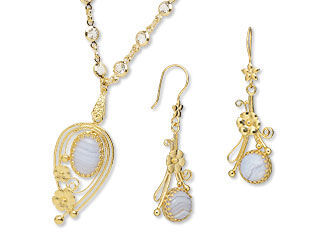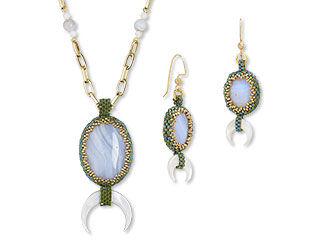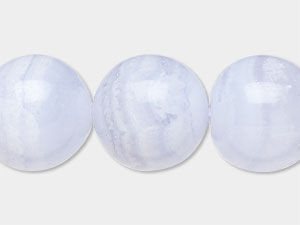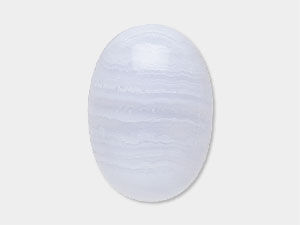Agate, Blue Lace Meaning and Properties
Blue Lace Agate History
Various types of agate, like blue lace agate gemstones, have been valued throughout history, all the way back to the Neolithic Era. It is believed these stones were originally used as amulets of healing, and this tradition continued through Ancient Greek and Egyptian civilizations. It's said the Greek philosopher Theophrastus gave agate its name because he found the stone in the Achates River of present-day Sicily, Italy. (The river has since been renamed the Dirillo River.)
Blue lace agate was first brought to the attention of the Western world in the 1960s, when it was discovered in Namibia, and named for the cloud-like white banding on its sky-blue surface. Since then, it has also been found in India, South Africa, China, Brazil, and Arizona and California in the United States.
What are the Metaphysical Properties Blue Lace Agate?
With its soft blue color, it's no surprise that blue lace agate meaning is said to involve soothing and peace. The circular, graceful banding is stimulating but still exudes a calm energy. Blue lace agate is said to be a stone of communication, making it easier for people to become confident and articulate. For this reason, it's considered a good idea to wear jewelry with blue lace agate or carry a stone in your pocket when required to speak in public. As a bonus, blue lace agate is sometimes referred to as the Stone of the Diplomat, helping ensure your words are not angry and your meaning is clear. Since agate has a slower vibration frequency than most stones, it is valued as a stabilizing gemstone. Agate is a birthstone associated with the months of May, June and even September, depending on the culture. Agate as a general gemstone is also connected to the Zodiac signs Gemini and Capricorn.
What Chakra is Blue Lace Agate?
Chakras are often described as luminous energy centers that connect body, mind and spirit in subtle harmony. Thought to influence everything from emotional well-being to the way we share our truth with the world, these centers are thought to be gently supported through the presence of meaningful gemstones. Blue lace agate, with its delicate bands of pale blue and white, is linked to the throat chakra and is believed to encourage soft, honest communication and inner stillness. Like a whisper of sky or a breath of ocean mist, blue lace agate is said to possess a serene energy that eases tension and opens the path to peaceful self-expression.
Throat Chakra (Vishuddha) - Teal or Light Blue
- Location: throat (thyroid)
- Represents: communication; growth via expression; secrets
- Emotional issues: communication; independence; listening; creativity; fluent thought
- Spiritual issues: sense of self; freedom to speak truth
- Physical issues: thyroid; esophagus; speech and other communication problems
- Gemstones: aquamarine, blue lace agate, turquoise
What is Blue Lace Agate Made From?
Blue lace agate is a type of variegated chalcedony, more specifically a variety of quartz. This type of agate is most notably recognized by its predominantly light blue banded layers that have also been known to include bright blue, white and brown hues. Agates typically form as nodules or geodes in igneous rocks. When an empty pocket or hole inside a porous rock fills layer by layer and the molecules begin to crystallize, bands of agate form. The color and banding patterns vary depending on pressure, temperature and the mineral content. The unique colors of various agates are sometimes enhanced through dyeing techniques. The art of agate dyeing was perfected in Idar-Oberstein, Germany, one of the most well-known areas for cutting and dyeing agates since the early 16th century.
Blue lace agate was first discovered in Namibia (originally South West Africa). Small amounts have also been found in Brazil, China, India and various places in the United States. Agates in general are found alongside multiple other rocks and minerals, including amethyst.
- Mineral Information: Microcrystalline quartz, chalcedony group
- Chemical Composition: SiO2
- Color: Blue, usually dyed these days
- Hardness: 6-1/2 to 7 (Mohs)
- Specific Gravity: 2.58 – 2.64
- Refractive Index: 1.530 – 1.539
How Do You Clean Blue Lace Agate?
Due to the soft color, some people assume blue lace agate is less durable than other agates, but don't let the color fool you. Agates tend to be hardy stones, making it a cinch to clean these gems. The best method is to rinse agates in warm, soapy water and use a soft brush to remove any extra dust or debris. Due to the soft color, some people assume blue lace agate is less hardy than other agates, but don't let the color fool you. It's still not the best idea to use harsh cleaners though, especially if your agate has been enhanced through any dyeing techniques.
Blue Lace Agate FAQ
Q: Is blue lace agate the same as blue agate?
A: Blue lace agate is not the same as blue agate. Blue lace agate is a naturally occurring gemstone, prized for its soft blue color and intricate, lacy banding. Blue agate, on the other hand, is typically made by dyeing white or gray banded agate, resulting in a bold, uniform blue hue.
Q: What treatments are used on blue lace agate?
A: Blue lace agate is rarely treated, as its natural lacy banding and soft blue hues generally need no enhancement. Lower-quality material may occasionally be dyed to deepen the color or stabilized with resin, but these treatments are uncommon.
Q: Are blue lace agate cabochons calibrated?
A: Blue lace agate cabochons are typically calibrated, although hand-cut, freeform and artisan varieties are also available.
Q: Does gold-toned jewelry-making components look good paired with blue lace agate?
A: With its icy blue hue, blue lace agate pairs well with both gold-toned and silver-toned components.
Q: What is blue lace agate meaning?
A: Blue lace agate meaning is said to center around calm communication, emotional clarity and gentle expression.
Designing with Blue Lace Agate
The soft hue of blue lace agate pairs exceptionally well with other pastel-colored gemstones. Looking at the bands of color, pair your blue lace agate with the tones of the bands to draw increased attention to the swirling pattern. For a complementary color pairing, blue lace agate provides a great base to draw attention to orange/red gemstones such as carnelian , sunstone , amber , coral and other forms of agate or banded jaspers. Learn more about color pairings with our color wheel . Blue lace agate looks especially beautiful when used with sterling silver or similarly light-colored metal materials, but also provides a lovely contrast to gold tones.
A Couple Design Inspirations to Get You Started
Shop for Blue Lace Agate
**Please note that all metaphysical or healing properties listed are collected from various sources. This information is offered as a service and not meant to treat medical conditions. Fire Mountain Gems and Beads® does not guarantee the validity of any of these statements.
How did you like this resource? Your feedback helps us provide resources that matter to you most.
Copyright Permissions
All works of authorship (articles, videos, tutorials and other creative works) are from the Fire Mountain Gems and Beads® Collection, and permission to copy is granted for non-commercial educational purposes only. All other reproduction requires written permission. For more information, please email copyrightpermission@firemtn.com.




